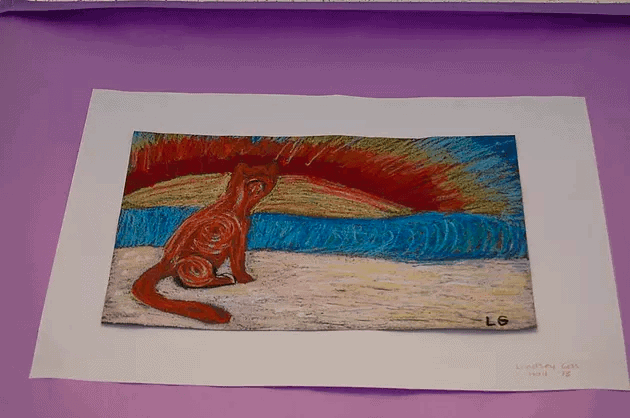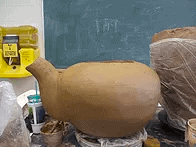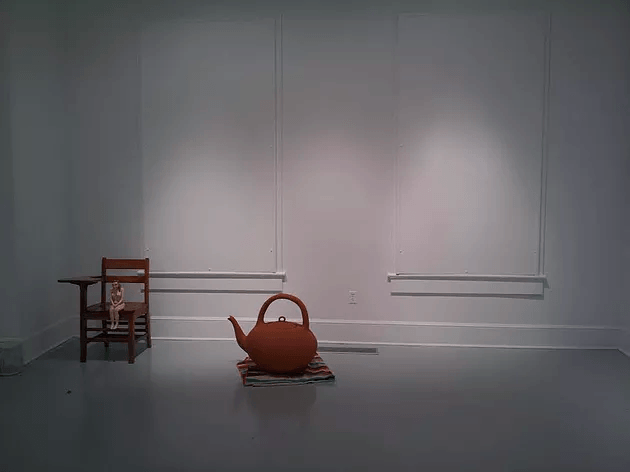Parents and Nannies here about the importance of art to children. So today, our Facebook live guest is Andrea Sammons, a licensed teacher and artist in North Dakota. Andrea earned her Master of Art in Teaching and Bachelor of Art in Studio Art-Ceramics from Georgia College and State University. Andrea is qualified to teach K-12 and she taught high school art for several years. Her passion is ceramics and pottery with her home potter’s wheel and kiln.
Tell me about your childhood and how art played a role in your development and growth.
Andrea: For me as a kid growing up in Georgia, I had art as early as I can remember. Honestly, there’s not a time I don’t remember art. I’ve always had a giant box of crayons, markers, color pencils and everything. When it rained, I went into the back yard and dug up clay. Art’s really given me a different mindset and I didn’t realize that until later in life. Art teaches me to think in different ways, guiding me towards a growth mindset.
Art was clearly your passion and major in college, how did Georgia College and State University develop a disciplined approach to your art.
Andrea: Before I went to college, I did art hit or miss and doodled or colored because I wanted to do it. Art is fun; something I can do; it’s easy. There was no rhyme or reason. After going to GCSU, it took a while but when I graduated, I left with a deeper appreciation of art. Art is more. I got very disciplined and more structured. I gained organizational skills to list materials, store materials, and when to refill them. Art also gave me a lot of direction. I could start with one idea and springboard to other ideas. Art is endless, and I learned how to refine methods to pursue things that pushed me as an artist.
Elizabeth: Emma is sharing that you are amazing and that you have taught her so much! She says to never underestimate how much art matters and how much it helps people.
Can you share a bit about how art helps people?
Andrea: It’s really cool to have a student watching. Although they think they learn a ton from me, by taking the course and learning to teach art, you can learn so much from them. I could walk into my class one morning, see someone is going through something, and change up the lesson to help. Art can be used to help people relax.
We had a class at 1 pm and we were hungry, waiting to go to the last lunch session. Students would come in bummed out and hangry. Sorry, this makes me so happy, I tear up a bit. They would come into that class and they would tell me that my class was the reason they stayed in school that day or just the reason to stay in school at all. The class was where they could come, and they knew they’d be safe and they could be 110% genuine. If you need to cry, then cry, do what you need to do. Sometimes they would have free art and could do their own work. They could be themselves and express themselves in a judgment-free environment.
Elizabeth: US Nanny Institute (formerlyAmslee) students who have taken your course are also watching tonight.
One of our Nanny Experts has shared that she really likes how the art class taught several different ways it was beneficial to children emotionally, creatively and so many other ways! She learned a ton from your class and wanted to say thank you.
Andrea: Thank you so much. I want you to feel that it has literally come from my heart and that you can place it in your heart and spread it around. I hope in the future others can benefit the same way, feel the same way, and I’m thankful for that.
Tell us your favorite story or a strategy for teaching a child about art.
Andrea: My strategy is connection and by connection, I mean I really like to engage with my students. I’d miss out on lunch with other teachers hanging with my kids watching YouTube videos. The goal is to break down barriers and be as real as possible. People may say they can’t care but I really do. That’s what art has taught me – you have to care, you have to connect. Art is a form of connection.
My favorite quote has guided me through teaching. It was by Paulo Frieire, “Accept the child where the child is at.” I think that’s really important when connecting, because not every person that comes in contact with you as a nanny is at the same level. You can have a four-year-old that’s is literate and painting masterpieces. Or you can have a 5-year-old who doesn’t know how to communicate verbally and needs the arts to connect with you.

My favorite story is about Lindsay, who I follow on Instagram and Snapchat. She’s going to be a senior this year which is mind-blowing because I taught her in the 7th grade. When she came into the classroom, she hated me, and she hated art. And, she’ll tell you, she was something. We slowly started to break down the wall and finally, we got to a project. I said that I didn’t care what she did for a picture, but I wanted her to care about it and to love. She said she had to draw her cat. I connected with her and we have to have cats in her artwork. More specifically, her cat Emory. I found out she named her cat after Emory Hospital. She had a loved one at the hospital and named the cat after the experience. It’s her way of finding a golden lining (not silver, he’s a golden cat) to get through life. The cat is her best friend and a model who takes great pictures. It brought life into her art that I had never seen before. That’s why I constantly go back to accepting the child where the child is and use that to make a connection.
Elizabeth: The stories you’ve shared have affected me and how I raise my son, especially understanding the child for where they are at. My son is young, and you taught me to slow down and to care about what he cares about. When he was drawing that stick house with crayons, I got on his level and had him explain and talk about his art, sharing with me what he was thinking. I never guessed what it was, I just listened to him tell the story. I never would have known to do that as a parent without you teaching me.
Have you ever had an art disaster?
Andrea: For the senior showcase, I did clay figures – four figurines paired with four objects. One of the objects was a giant teapot – about 3 feet tall and 3 feet wide with about 300 cups of tea. It’s huge. I picked teapots because in an earlier course, I only made 8 small teapots in the span of a semester and needed 20. I learned the teapot is an extremely hard form and I felt it was the biggest challenge I needed to overcome.
 For my showcase, I ended up making 2 of these giant teapots. One Saturday, 3 months after starting the project and with over 120 pounds of clay, smoothed into the form, I walked in and saw the whole teapot had peeled away from the base. So instead of a beautiful round piece, I had a four-foot-long slab of clay laying on a table. This was 3 months of my work with only a month left until my showcase, which determines if I graduate.
For my showcase, I ended up making 2 of these giant teapots. One Saturday, 3 months after starting the project and with over 120 pounds of clay, smoothed into the form, I walked in and saw the whole teapot had peeled away from the base. So instead of a beautiful round piece, I had a four-foot-long slab of clay laying on a table. This was 3 months of my work with only a month left until my showcase, which determines if I graduate.
I literally threw it off the table, left for a while, then later that day, I started again. I finished the project in 2 weeks instead of 2-3 months, but I learned from my professor that I attached it too soon. It was too much too soon. I learned a lot from this failure. I learned how to dry it quicker and the steps. Although I lost months of work and freaked out, I learned a lot. It taught me how to slow down and focus even as I worked quickly. I was paying attention to my steps – how I was connecting, when I was connecting, that way I wouldn’t lose it again. It survived the second time, whoo!

How can you use household items or very low-cost items creatively when playing with kids?
Andrea: I’m going to quickly covers stains, every shirt I own has stains. I get paint everywhere; my husband will tell you that I get clay everywhere. To prepare for kids to paint or do art, you can prepare. The best advice is to have newspaper, plastic wrap everywhere you are going to be – preferably outside. Not just a little space, but the big space around them. It’s why we use giant tables that can be easily washed. Try to keep it there and not on the floors or the ceiling.
If you get stains in fabric, use COLD water. I learned the hard way, don’t use warm water. And don’t scrub but dab lightly. From experience, you can save a few things, but not everything.
For cheap supplies, look at junk emails and get emails from everyone. There will be times Hobby Lobby has a great sale on construction paper. You can use construction paper for sculptures, paper mache, you can do anything with it. By getting all the email, you get the information without having to go to the store to see it.
We also did reclaimed projects – we literally used junk and trash. You can look them up on Pinterest. We used old toilet paper roll, pine needles, pine cones, rice, beans – anything. They took an old painting or artwork and re-created it with the items. They had to color match and find things that looked similar or could be manipulated to look like the other artwork. It’s easier than you think to find cheap stuff, you have to look and save stuff.
Since anyone can do art and it’s so easy, why do we need a class and a focus on art?
Andrea: I’m really passionate about this and some of my kids ask me why we need an art class. I feel it’s important to have a class or time set aside to work together and to look at other art. Not just do the art that’s in our head, as there is a lot of art in the world. We see art, we take it in, but we don’t necessarily know it. It’s good to have time to look at things you might not normally look at to have a greater appreciation and learn how to reflect and respond to what’s going on around you. I think it helps you learn more about the meaning of your life and everyone else life because you are seeing everything and bringing it together. You can communicate art with others but at the same time, you don’t have to.
I love art and I think without it, we’ll see a lot of suffering in our youth and younger children. Not everyone knows how to express themselves and art allows you to express yourself in any way, shape, or form. In learning art, you also learn how to manage things that are going on in your life.
Thank you so much for teaching our Children and the Art class as well as for doing your first Facebook live leap with us! I’m sure we’ll have you again, thank you! To learn more, a Children and the Art course is available with enrollment in the Advanced Childcare program.


Recent Comments